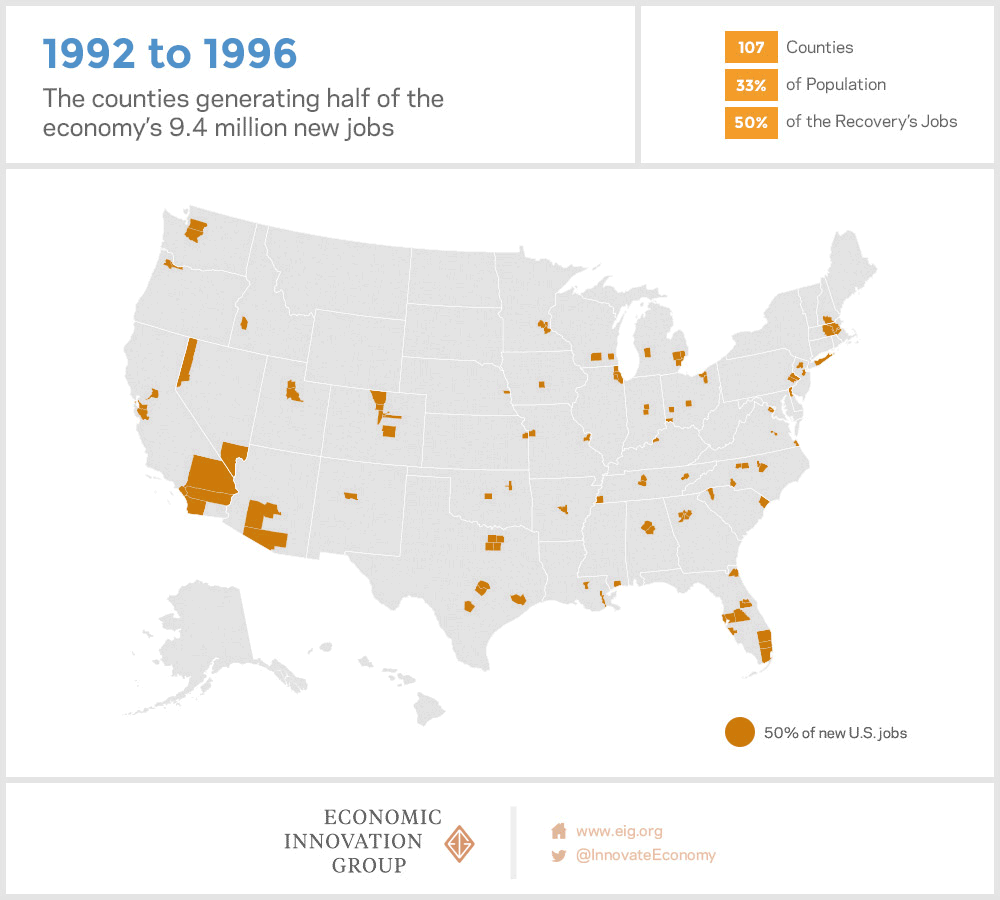Last week we learned that Chicago, according to the latest Census numbers, had lost population for the first time this decade. Furthermore, America's fourth-biggest city, Houston—which had been adding 100,000 new jobs a year until recently—continued to grow, with current trends suggesting it would pass Chicago in population in just 13 years.
And the population loss landed on top of a pile of similarly grim numbers: rising homicides and shootings, massive proposed cuts to Chicago Public Schools, deepening pension debt. Could anything go right? Maybe so.
The Economic Innovation Group just published an analysis of Census data, job growth, and new-business creation (as first pointed out by Daniel Kay Hertz). And while the national picture is concerning, the news for Chicago is somewhat encouraging.
Take this national map. It's a somewhat odd way of slicing the numbers up—where just half the jobs in America were created during different post-recession periods—but its purpose is to show that job creation since the Great Recession has concentrated in urban areas. One of those is Chicago. It covers three periods: 1992-1996, 2002-2006, and 2010-2014. In that middle period, Cook County vanishes from EIG's count.

This second one is a bit more illustrative of the overall point they're trying to make—that new business growth was concentrated in urban areas during the latest recovery. In that period, Cook County stands alone not just in Illinois, but in the Midwest.

Digging deeper into the report, the numbers back it up. Cook and the collar counties all saw a positive net change in business establishments from 2010-2014; only 12 others in Illinois (which has 102 counties) saw growth. Cook added 2,960 net new establishments, 12th-highest in the country. That's not fantastic. Los Angeles County, with about twice the population, added about five times more establishments. Harris County, home of Houston, has about 750,000 fewer people and added about twice as many establishments. Chicago was practically even with Maricopa County, where Phoenix has been adding population, but is still about one million people shy of Cook. But given the county's issues with population growth, it's also not bad, either.
There's a similar pattern with employment. Cook County's employment growth rate was 7.6 percent from 2010-2014, less than Maricopa (8.2 percent), Los Angeles (9.9 percent), Harris (14.7), San Francisco (16.8!), and so on. But its population growth rate was just one percent during that same period.
A modest employment-growth rate and new business creation mixed with stagnant population change suggests opportunities in the labor market. And a new report from CMAP echoes that. The unemployment rate for the Chicago metro area is still well above the national rate. And it did just spike, to 6.4 percent. But the unemployment rate is tricky. As the authors point out, the Chicago-area workforce spiked as well—to five million people, the largest on record.
That can actually increase the unemployment rate, which is shorthand for the Bureau of Labor Statistics' U-3 measure of unemployment, which is people who are unemployed but who have looked for work in the past month. For example, the unemployment rate for the Chicago-Naperville-Arlington Heights metropolitan division went up from 6.1 percent to 6.3 percent from March of last year to March of this year. But more people are actually working, about 53,000; it's just that the labor force grew by about 64,000. Statewide, the number of discouraged workers (who haven't looked for work in the past month because they don't think it's out there) and involuntary part-time workers (who want to work full-time but can't find a job) declined from 2010-2015.
Depending on your frame of reference, this is not necessarily good news. As Jim Tankersley writes in the Washington Post, "nearly 2 out of 3 rural counties lost businesses, on net, from 2010 to 2014. That is up from just over 2 in 5 counties in the early 2000s and just under 1 in 5 in the ’90s." Rural counties form a lot of the country; they're a lot of the state of Illinois, and there's a great deal of poverty and job loss in rural downstate counties, straining the budget of a state that's struggling to keep the social-safety net functioning. The Chicago metro area has long been the fiscal engine of the state; even if it can run faster in the coming years, it could have even more to pull.



